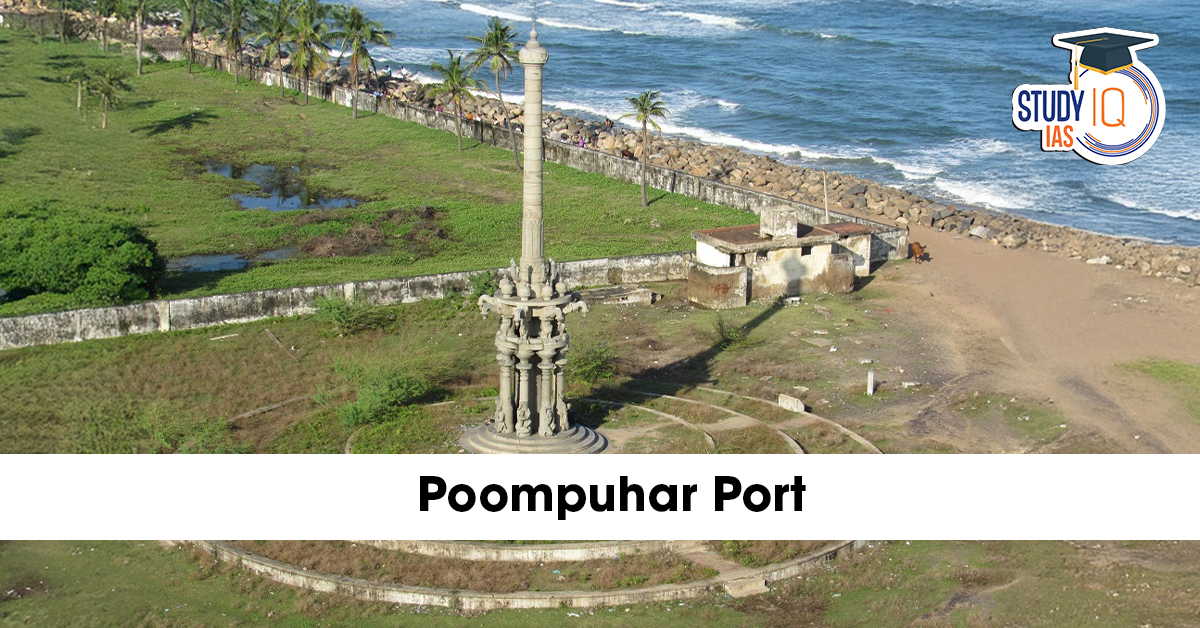Table of Contents
The ancient Poompuhar Port, also known as Kaveripoompattinam, has once again come into the limelight as the Tamil Nadu State Department of Archaeology (TNSDA) successfully completed the first phase of an underwater archaeological survey off its coast in Mayiladuthurai district. This significant exploration aims to uncover submerged remnants of the legendary Sangam-era port city, believed to have been lost to the sea centuries ago.
Historical Background of Poompuhar
Poompuhar, situated near the Cauvery River’s mouth on the Bay of Bengal, was one of the most flourishing port cities during the Sangam period (circa 300 BCE – 300 CE). Ancient Tamil literary works such as the Silappatikaram and Manimekalai vividly describe the city’s urban layout, thriving trade, and cultural vibrancy.
It served as a major maritime hub, facilitating trade between the Chola kingdom and distant civilizations, including Rome, Greece, and Southeast Asia. Over time, geological changes and sea-level rise caused the submergence of parts of this ancient city under the Bay of Bengal.
Underwater Archaeological Survey 2025
The TNSDA, in collaboration with Indian Maritime University and with technical support from local fishermen, conducted the first phase of the underwater archaeological survey between September 20 and October 2, 2025.
Key Details of the Survey
-
Duration: 12 days (10 a.m. to 3 p.m.)
-
Depth Covered: Up to 23 metres below sea level
-
Tools Used:
-
Remotely Operated Vehicle (ROV)
-
Side-scan sonar
-
Sub-bottom profiler
-
Multibeam scanner
-
These advanced instruments were used to map the ocean floor, detect structural anomalies, and identify potential man-made formations.
Exploration Process
The survey team consisted of 10 divers and 4 trained experts from Indian Maritime University. They explored the seabed between Thirumullaivasal and Neithavasal, two coastal regions near Poompuhar. The team operated from mechanised and fibre boats to reach different survey points, ensuring maximum coverage.
The focus was to identify remnants of ancient structures, artifacts, or urban layouts that could confirm the existence of a port city submerged thousands of years ago.
Significance of the Discovery
The Poompuhar underwater survey holds immense archaeological and historical value. It is expected to:
-
Reveal insights into ancient Tamil maritime trade and cultural exchange.
-
Provide evidence of advanced urban planning and coastal engineering in the Sangam era.
-
Support ancient Tamil literature with scientific validation.
-
Contribute to heritage tourism and marine archaeology in Tamil Nadu.
This survey follows earlier underwater explorations in Korkai (Thoothukudi district) and earlier surveys conducted in Poompuhar nearly three decades ago by veteran archaeologist S. R. Rao.
Next Steps
According to R. Sivanantham, Joint Director of TNSDA, the data collected from the first phase is currently under analysis. The department plans to conduct another round of underwater exploration once weather and sea conditions are favourable.
The findings from these surveys could potentially redefine our understanding of ancient Indian maritime history, offering a glimpse into the life and trade networks of the Sangam-age Cholas.
Conclusion
The Poompuhar Port excavation is not just a search for lost ruins—it’s a quest to reconnect with Tamil Nadu’s glorious maritime heritage. As the Bay of Bengal continues to reveal its secrets, Poompuhar stands as a symbol of India’s ancient global connections, technological prowess, and cultural legacy.


 Economy Beyond Headline Numbers: Why Ind...
Economy Beyond Headline Numbers: Why Ind...
 Digital Constitutionalism in India: Prot...
Digital Constitutionalism in India: Prot...
 Rethinking Urban Governance in India
Rethinking Urban Governance in India

























